Azulejo tiles in Porto were one of the first things that caught our eye during our trip to Portugal. Azulejos, also known as Portugese tiles, are particularly famous in Porto and Lisbon. The beautiful blue tiles are gorgeous to look at, very colourful, and a well-known sight in Portugal’s towns and cities.

This post may contain affiliate links, which means that we may earn a small commission for qualifying purchases. More info: disclosure.
Azulejos have been used for centuries to adorn the facades of buildings, interiors of churches and palaces, and are considered an important part of Portugal’s cultural heritage.
As we explored Porto we noticed the eye-catching azulejo tiles decorating everything from benches, street signs and fountains to the walls of train stations, churches and cathedrals. There are even azulejos adorning huge boulders and public art in Porto.
Some of the Portugese tiles portray historic rustic scenes while newer azulejos are decorated with intricate geometric designs or flowers. Most are blue and white tiles but there are others in the traditional Mediterranean colours of green and yellow.
Want to see the best azulejos in Porto for yourself? In this guide I’ll tell you where and how to find the best azulejos in Porto. But first…
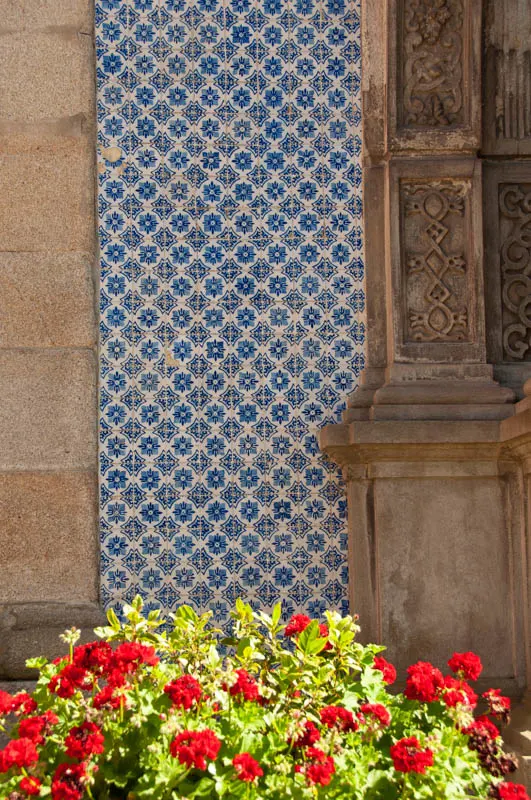
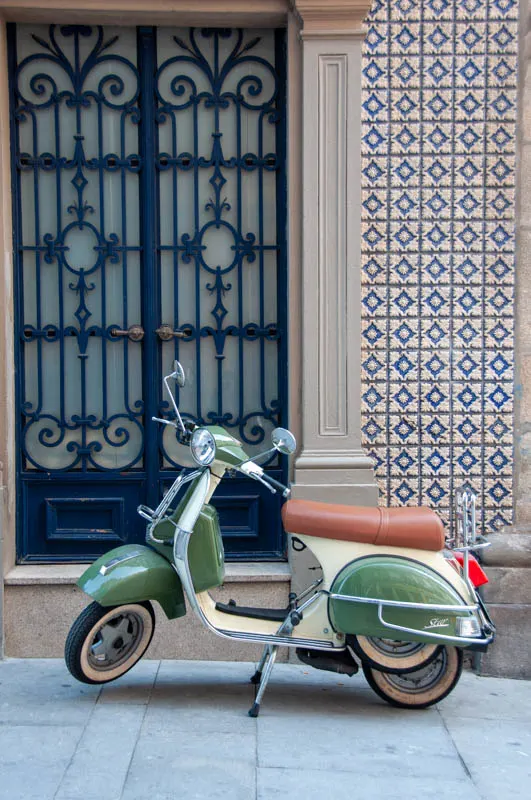
The name azulejo and where it comes from
Contents
In the 13th century parts of southern Portugal were under Moorish rule. The Moors introduced the use and production of Azulejo tiles to the country and the word azulejo originates from the Arabic word az-zulayj meaning ‘small polished stone’.
Some believe the name comes from the Portuguese ‘azul’, which means ‘light blue’. Either way, try saying azulejo out loud, it rolls beautifully off the tongue.
Under Islamic law, the tiles produced by the Moors were forbidden to portray human forms or faces. The intricate geometric patterns and floral designs like those in the beautiful Alcázar of Seville were the result of the Moors abiding by these laws.
A short history of Portugese Azulejo tiles
King Manuel I of Portugal brought Azulejo tiles from Seville in 1503 to decorate his palace at Sintra near Lisbon. As well as being highly decorative, the tiles are hugely practical and were used to keep the interiors of the palace cool in the heat of summer.
The ceramic tiles, with intricate designs and ornate reliefs, were used to decorate vast areas of blank plaster. As they required minimal maintenance it turned out to be a win win situation. So much easier just to give them a quick wipe them down instead of paying for a whole new paint job don’t you think?
The first tiles were initially imported from countries like Spain, Italy and the Netherlands until the Portugese were able to produce their own azulejos in the 16th century. It was then that the Portugese turned away from the geometric shapes of the Moors and started to use human and animal figures on the Azulejos to portray historical scenes. Over a century of painting geometric patterns has got to give at some point hasn’t it?
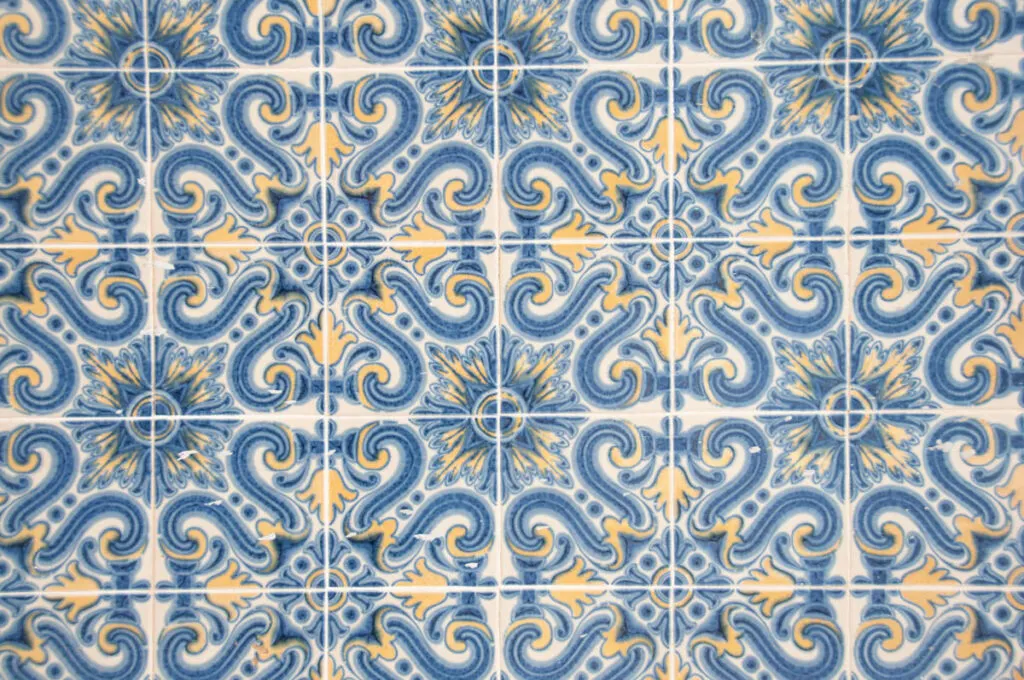
This practical and decorative tiling tradition became a way of telling stories and recalling historical events throughout Portugal. It was also a way of portraying rustic scenes and documenting the Portugese way of life.
Today, the mass production of tiles in Portugal means that building owners use them as a matter of course to embelish homes, shops and businesses. These beautiful Portugese tiles can be seen all over Portugal.
You don’t actually have to look too far to find azulejos in Porto because they’re pretty much everywhere. However, if you only have a short time in the city you’ll want to seek out the most beautiful and impressive azulejo tiled facades. Many of them are located in the historic centre of Porto and it’s easy to get around to them all on foot.
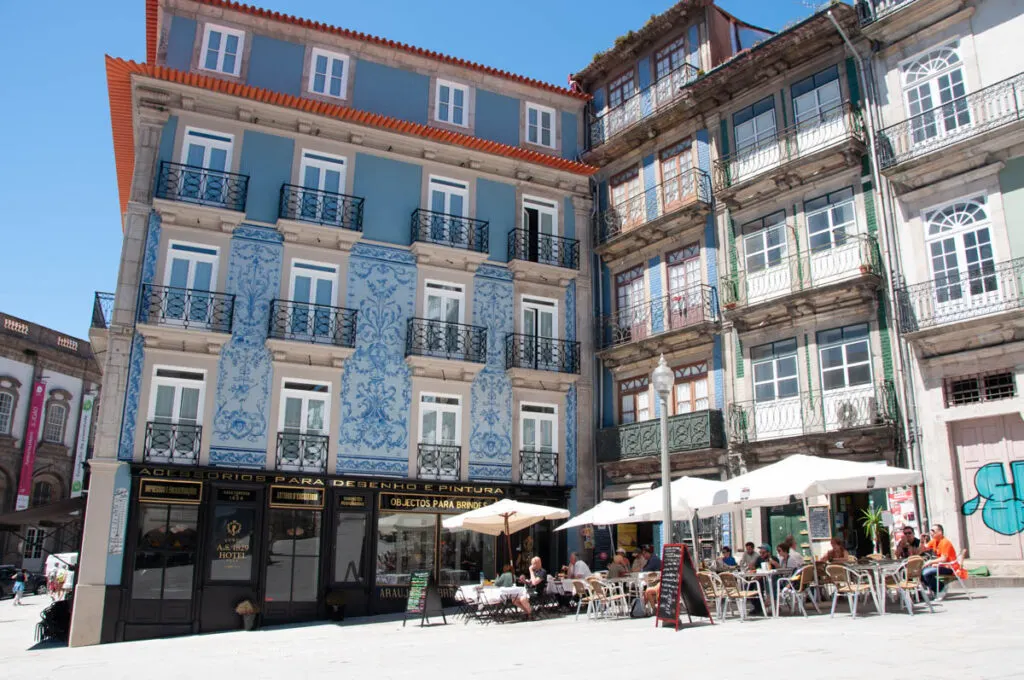
Where are the best azulejos in Porto?
The best azulejos in Porto can be easily located around the city. Some of the best examples are the following sites:
- São Bento Station
- Porto cathedral (Sé do Porto)
- Igreja do Carmo
- Casa da Música
- Igreja de Santo Ildefonso
- Capela das Almas
Let’s take a look at Porto’s azulejo sites in more detail…
Azulejos at São Bento Station
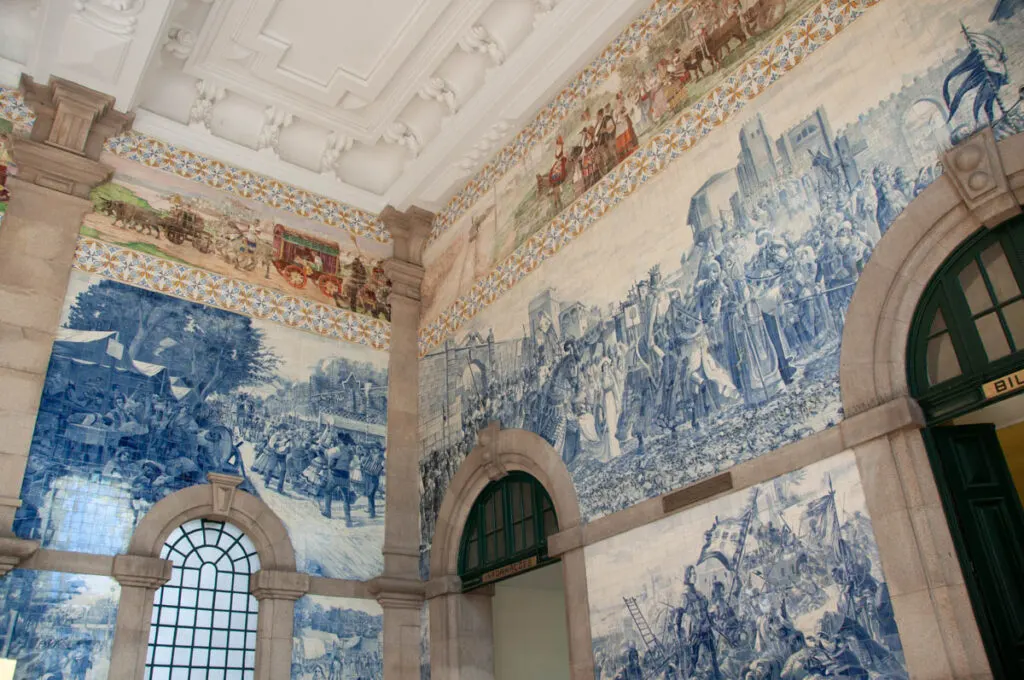
Probably one of the most beautiful railway stations in the world and the most well-known tiled building in Porto is the São Bento Railway Station. It’s one of the best places to see the hand-painted tiles with over 20 thousand blue and white azulejos covering the walls of the station main hall.
Sao Bento train station is a UNESCO World Heritage site and an important Portugese national monument and is a must-visit on your first time in Porto.
The azulejos tiles were painted by Jorge Colaço, the most important azulejo painter of the time, from 1905-1916. The azulejos illustrate the history of Portugal as well as pastoral and biblical scenes.
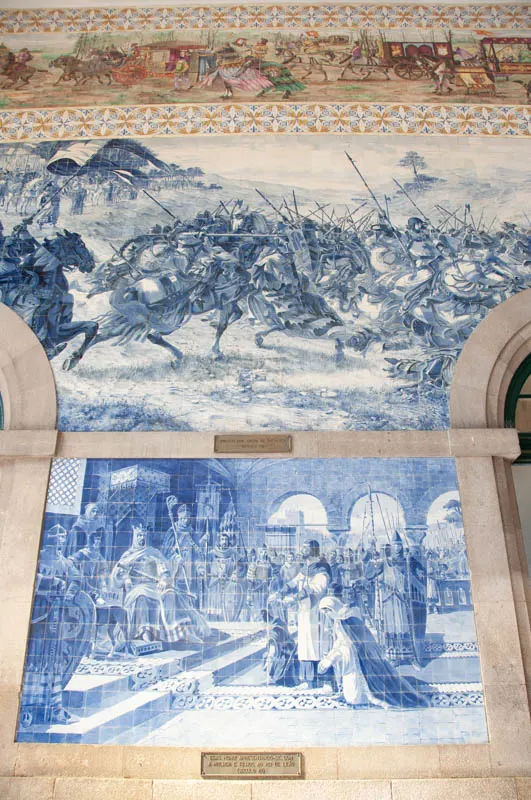
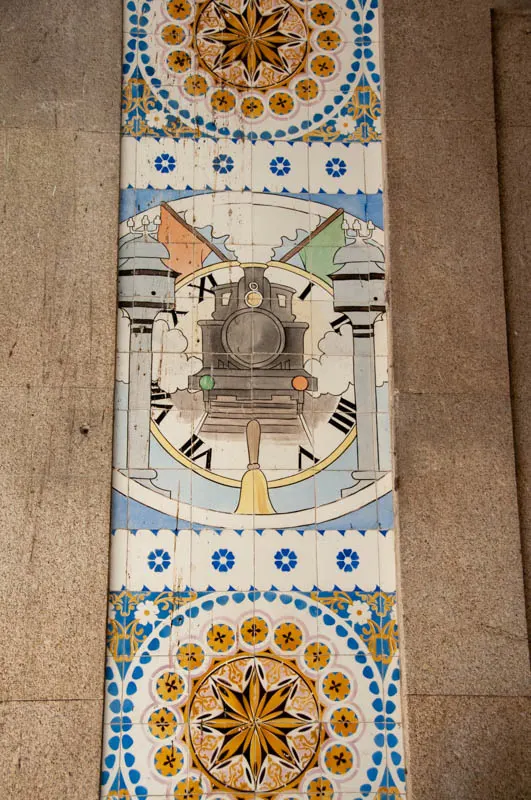
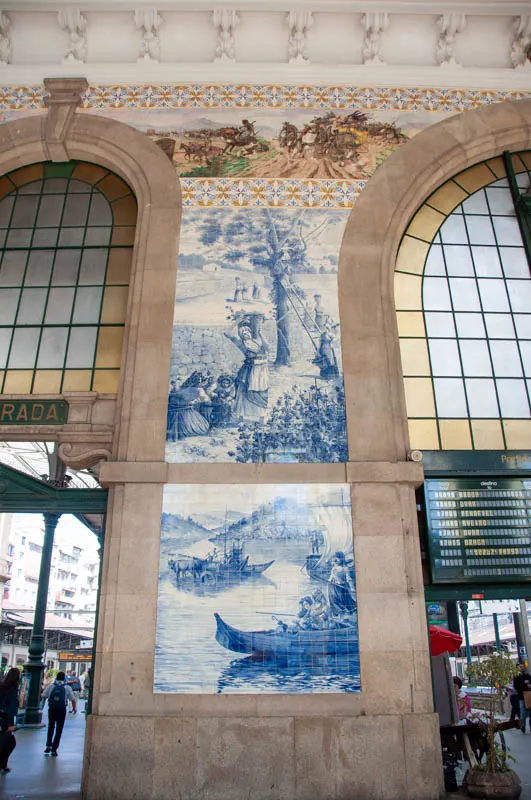
We stood and craned our necks checking out the fascinating scenarios and found some more unusual tiles amongst the artwork. However, be careful – you could easily miss your train while engrossed in the station’s epic tiles.
You don’t need to buy a train ticket visit and can just pop into the station to view the beautiful azulejos.
You can take a train to Pinhão station in the Douro Valley. Pinhão station is also a beautifully tiled station with some very colourful azulejos. the train journey is a great way to see the Douro River. Read about my historic steam train journey through the Douro Valley.
Where: Praça de Almeida Garrett, 4000-069 Porto, Portugal
How to visit: take a guided tour
For a different take on Porto’s azulejos there is a modern public art installation just opposite Sao Bento Station where large tiled boulders can be found.
Sé do Porto: Porto Cathedral
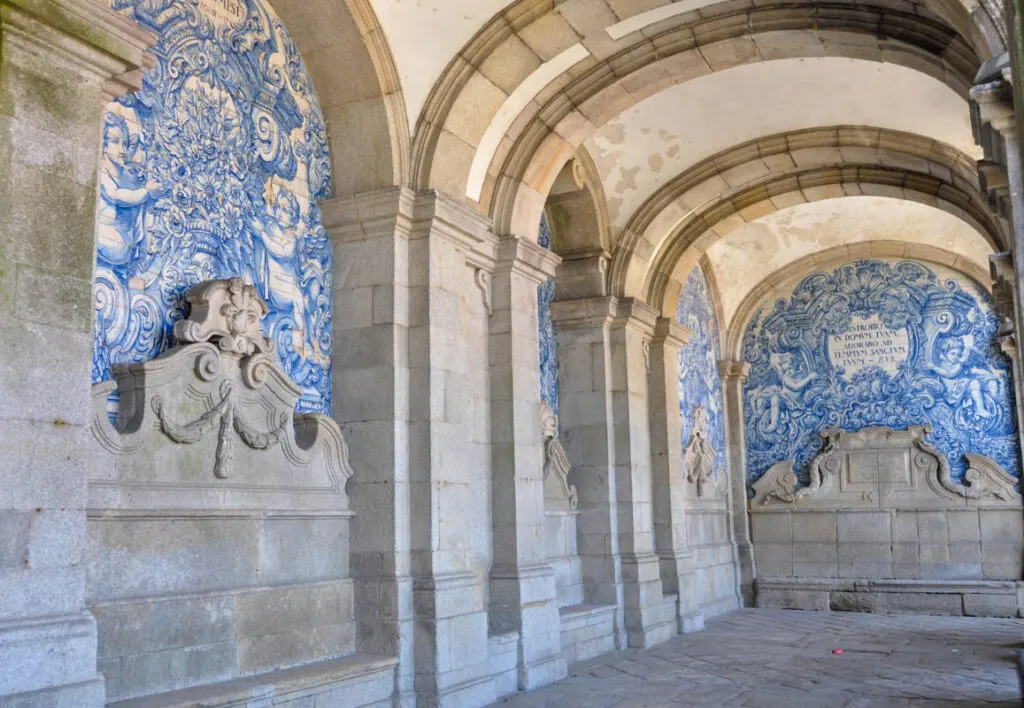
Porto Cathedral, also known as the Sé do Porto, is a huge cathedral located in the historic center of Porto, Portugal and is one of the city’s oldest monuments.
The cathedral is known for the intricate Portugal tiles, which adorn its walls of the cathedral and the interior. These azulejos were created in the 17th and 18th centuries and depict scenes from the life of Christ, as well as scenes from Portuguese history. The azulejos are considered some of the finest examples of this traditional Portuguese art form and they contribute to the cathedral’s rich cultural heritage.
Not to be missed is the small gothic cloister in the South transept. It’s adorned with blue ceramic tiles by Valentim de Almeida which were created between 1729 and 1731. The cloisters are one of the best spots for photos and a favourite with Instagrammers. The contrasting stone arches and delicate painted tiles are stunning and it’s a great place to shelter from the sun.
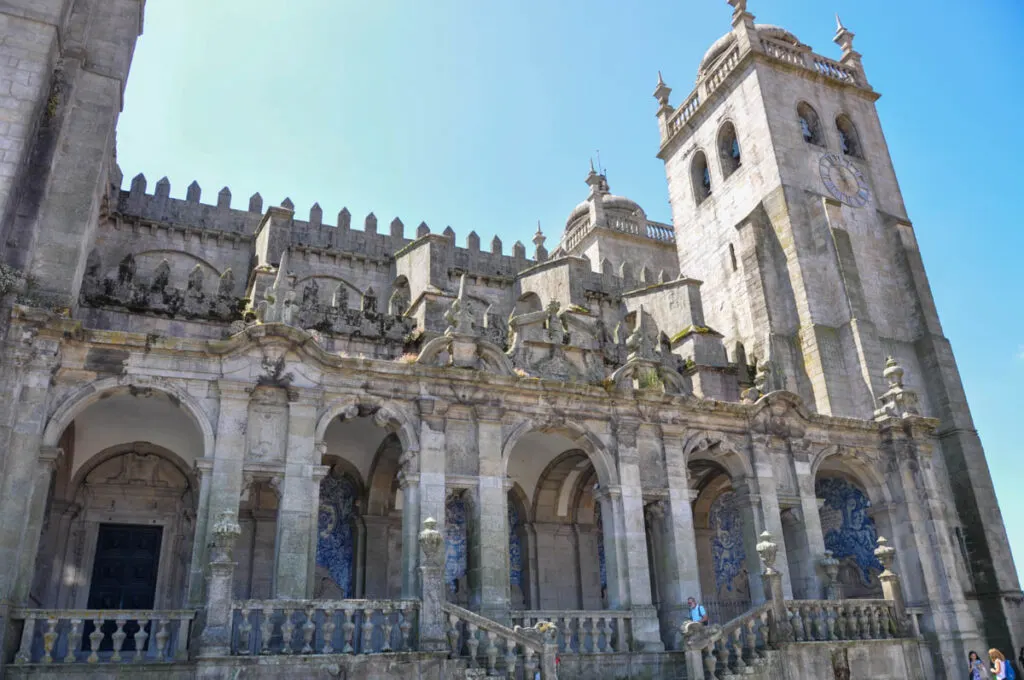
Visitors to Porto Cathedral are often struck by the beauty of the azulejos and the intricate details that have been captured in these works of art. They are an important part of the cathedral’s history and provide a glimpse into the cultural heritage of Portugal.
Where: Terreiro da Sé, 4050-573 Porto, Portugal
How to visit: Take a walking tour of Porto
A visit to the main part of the cathedral is free but a small fee is payable to visit the cloisters and museum.
Igreja do Carmo
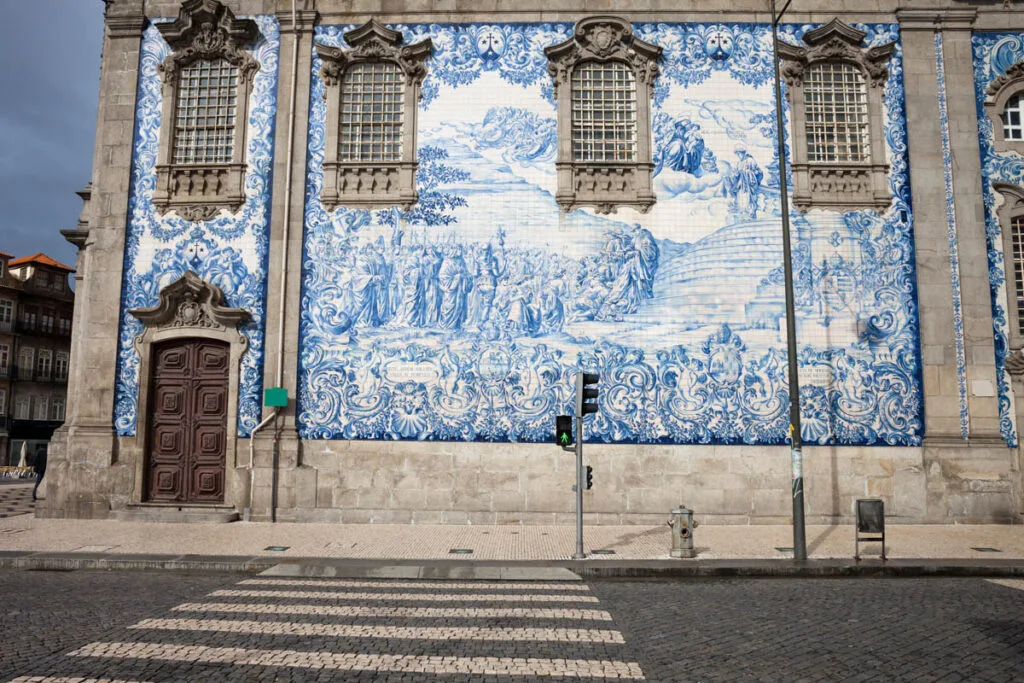
Porto’s Igreja do Carmo is a beautiful church known for its late Baroque architecture. The church was built in the mid 17th century and has an impressive outside wall decorated from top to bottom with beautiful tiles which were added in 1912. The tiles show scenes of the founding of the Carmelite Order and were designed by Silvestro Silvestri.
The interior is also worth a look and is decorated with gilded altarpieces, intricate tile work, and has a magnificent frescoed ceiling.
Next door is a second church, Igreja de Carmelitas, which was built for the nuns of the Carmelite order and between the two churches sits a very narrow, three-storey house.
It’s said that the one-metre wide house was built to separate the monks from the nuns but was more likely built for aesthetic reasons, filling in the narrow gap between the two churches.
Igreja do Carmo and its sister church are just a short walk from the Clerigos Tower which is worth climbing the 224 steps for incredible views across the Douro River to Vila Nova de Gaia.
Where: Rua do Carmo, 4050-164 Porto Portugal
Casa da Música
The Casa da Musica is a striking contemporary building designed by architect Rem Koolhaas and completed in 2005.
This contemporary concert hall is considered an important landmark in the city but as well as it’s modern exterior it’s also known for its contrasting use of traditional azulejos on the interior. The VIP hall has one complete wall and a slanted ceiling entirely covered in azulejo tiles and it’s absolutely stunning. It’s fascinating to see the tiles displayed in a way other than on a flat wall and it makes for an incredible visual feast.
If you visit take time to check out the unique black-and-white tiled roof terrace with views of the Rotunda da Boavista.
There’s an entry free for Casa Musica but the Porto Card gets you a 50% discount.
Where: Av. da Boavista 604-610, 4149-071 Porto, Portugal
Igreja de Santo Ildefonso (Church of Saint Ildenfonso)
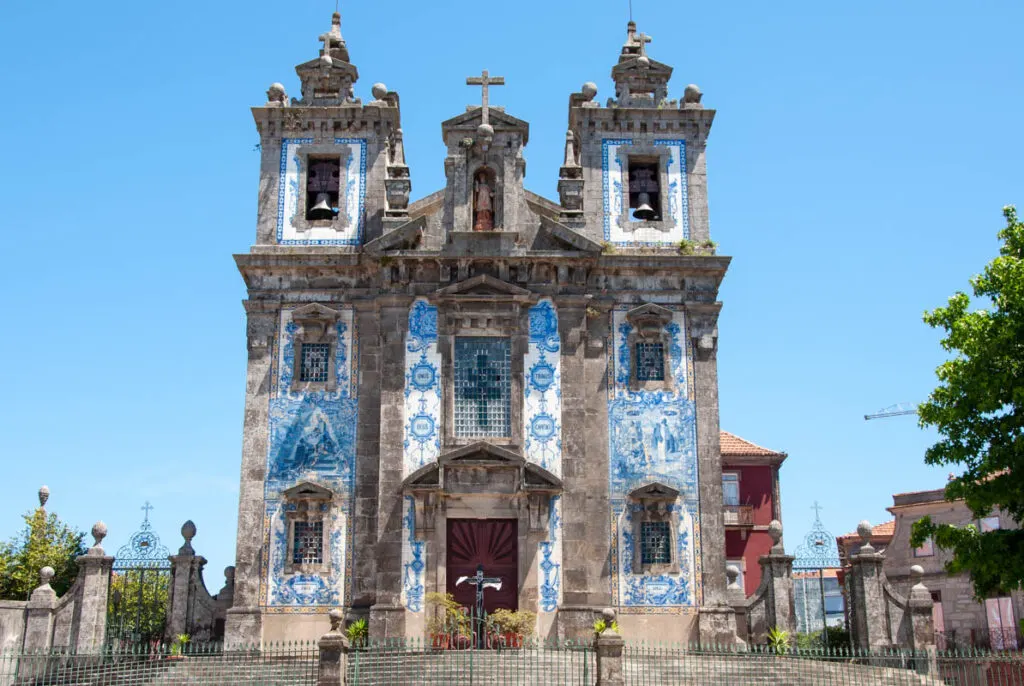
Another building in Porto with the mark of artist Jorge Colaço is The church of Saint Ildefonso. The 18th century church facade is covered in nearly 11,000 azulejo tiles and is considered to be one of the most important examples of Baroque architecture in Portugal.
The tiles are newer than those in São Bento Station and were added to the church in 1932. The church is a UNESCO World Heritage site and on the day we saw it the colour of the sky mirrored the blue of the azulajos perfectly.
The church is quite close to the Livrello Book Store so it’s worth making time to combine a visit to both.
Where: R. de Santo Ildefonso 11, 4000-542 Porto, Portugal
Capela das Almas (Chapel of Souls)
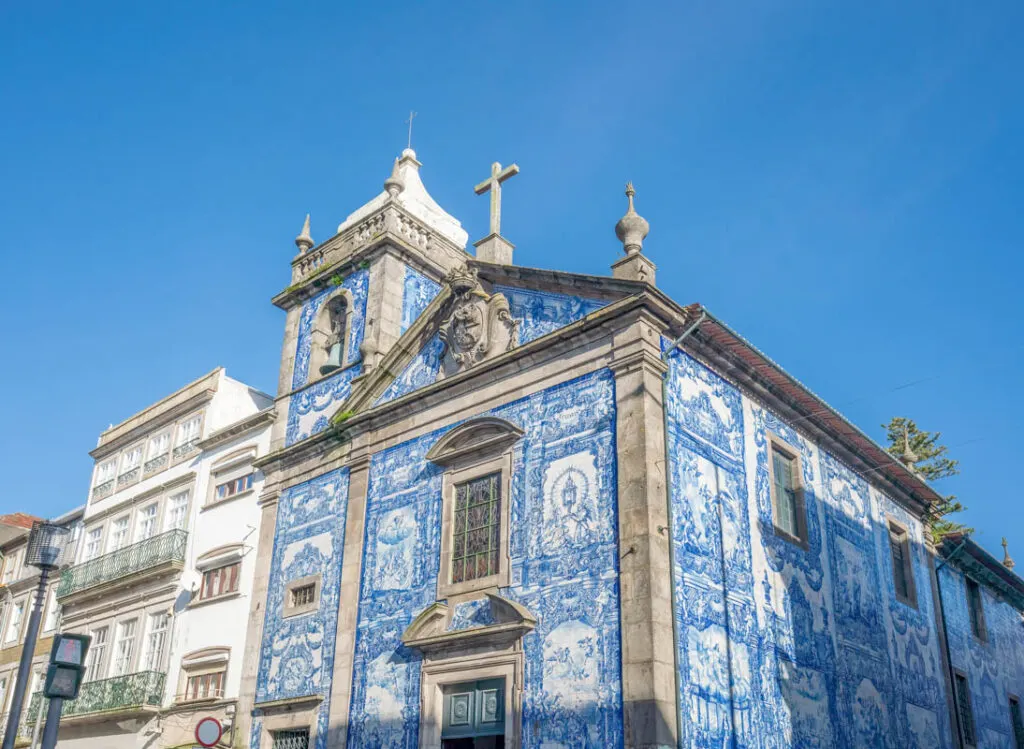
Capela das Almas, also known as Chapel of the Souls was free of tiles until 1929 when the missing and damaged tiles were replaced. Today the roof of the church is covered in almost 16,000 tiles, all designed by Eduardo Lait and produced by the Viuda Lamego ceramic factory based in Lisbon.
The tiles represent the phases of the life of San Francesco d’Assisi and Santa Caterina. Pop inside to check out the stained glass windows while you’re there.
Where: Rua de Santa Catarina 428, Porto, Portugal
Igreja dos Congregados
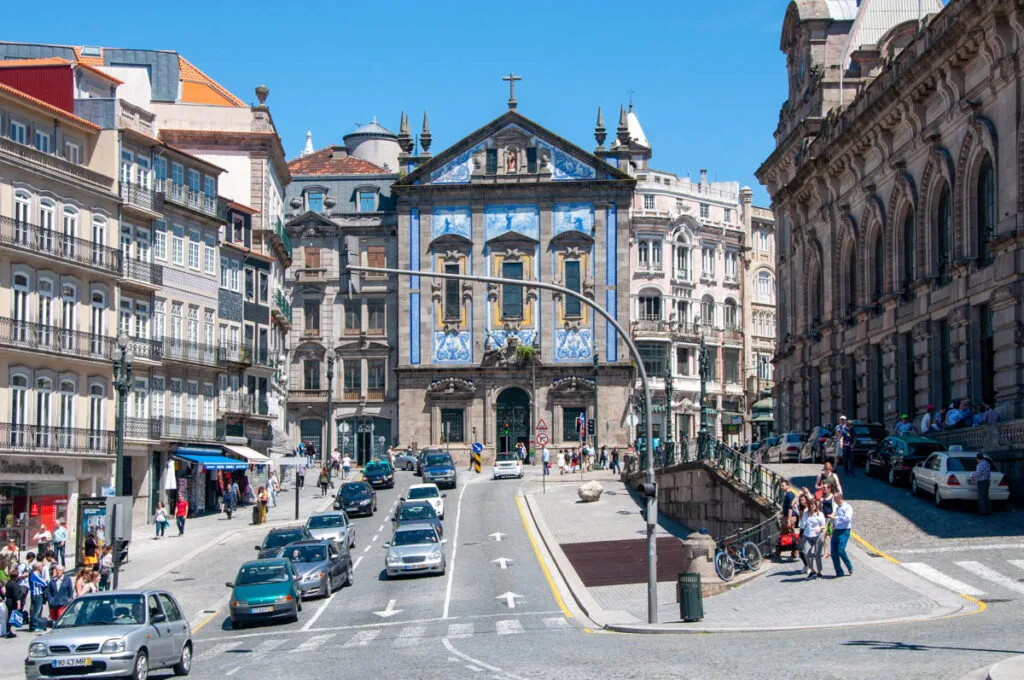
Translating to Church of St Anthony’s Congregation, you’ll find this baroque church just opposite São Bento Station. The tiles on the facade are contrasted with yellow which stand out strikingly against the stonework of the church.
As well as the colourful azulejos it’s worth stepping inside to view the gold leafed alter and various graves, encased in glass, around the sides of the cathedral. Note that the church is closed unless there’s a service in progress.
Where: R. de Sá da Bandeira 11, 4000-433 Porto, Portugal
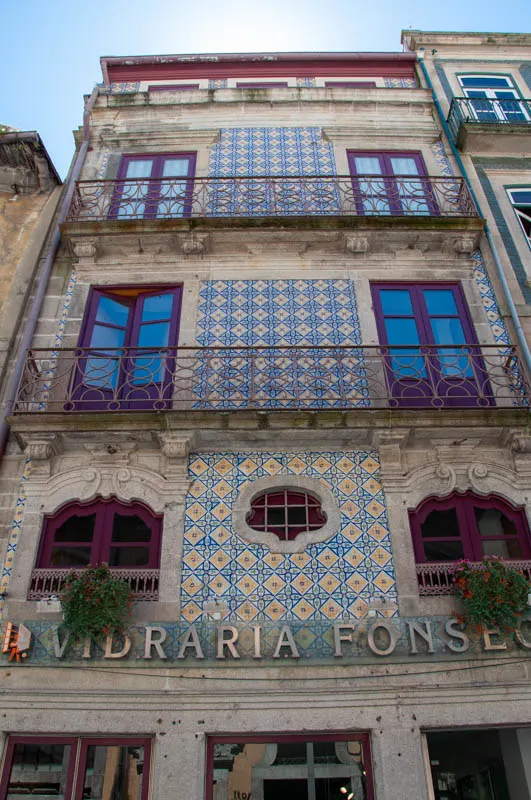
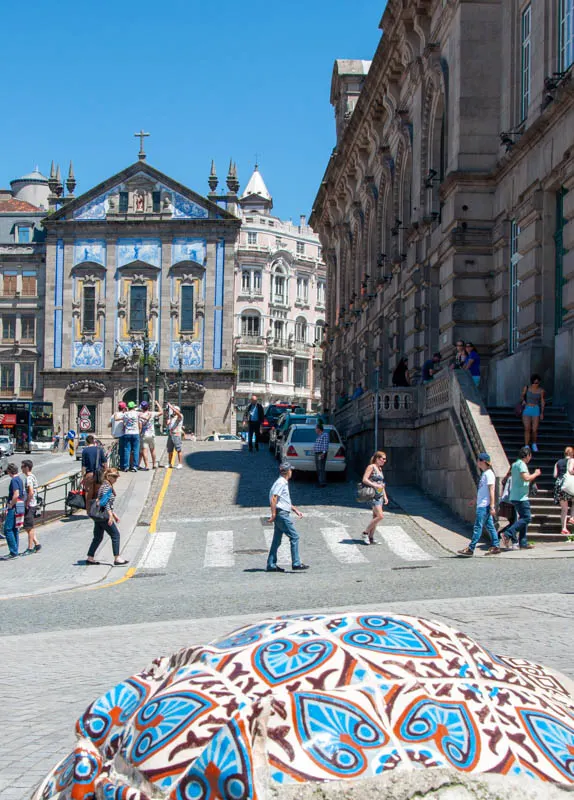
The National Azulejo Museum, Porto
Visitors to Porto can also visit the National Azulejo Museum to learn more about the history, techniques, and artistry of these iconic Portuguese ceramic tiles. The museum showcases a wide collection of azulejos from different eras, including pieces from the 16th and 17th century to the present day.
A visit to the azulejo museum offers a fascinating insight to the history of Portugal’s blue and white tiles.
Where: Praça de Carlos Alberto 71, 4050-159 Porto, Portugal
Where to buy azulejos in Porto
You can buy authentic azulejos in Porto and they make a beautiful authentic souvenir of your visit to the city. There are a number of small artisan tile makers as well as some larger shops that will have beautiful azulejos for sale. They come in a variety of sizes and styles and you’ll be hard-pressed to choose from all the options available.
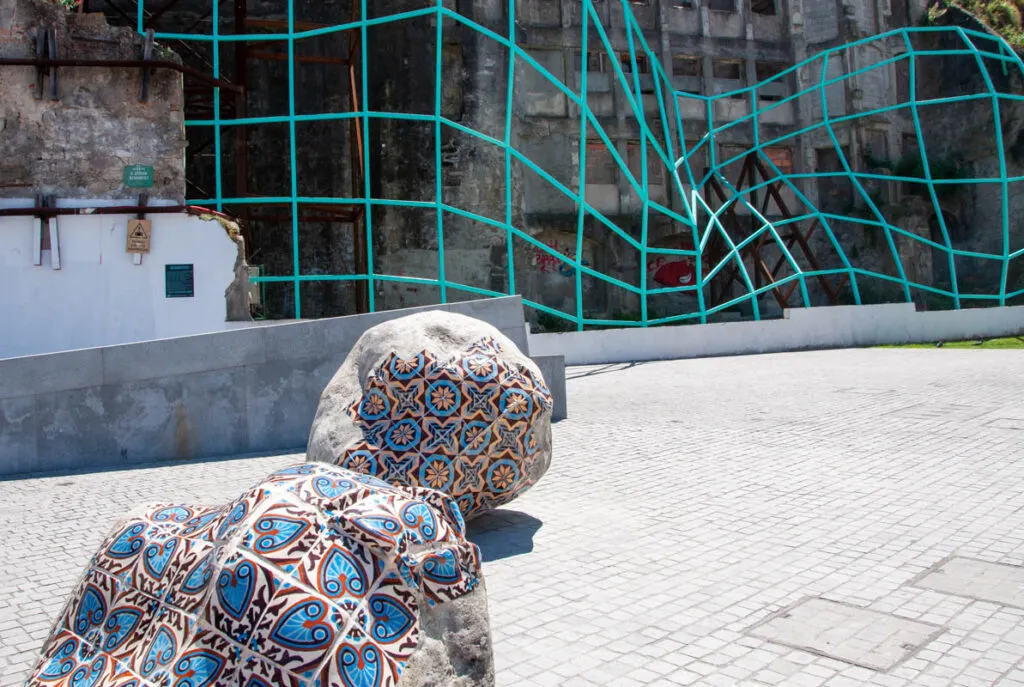
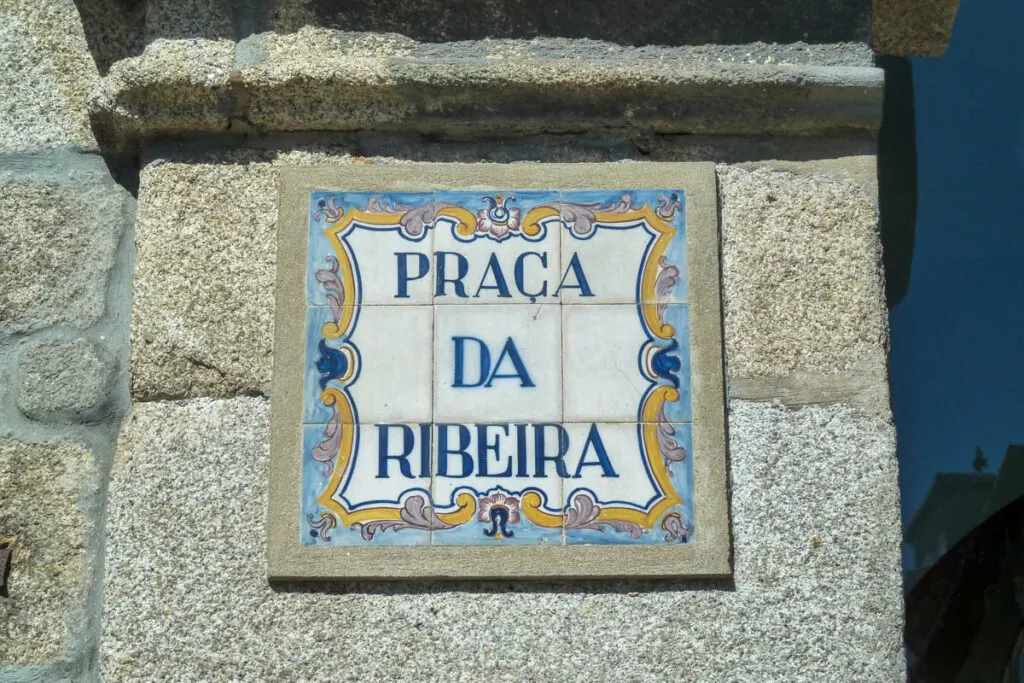
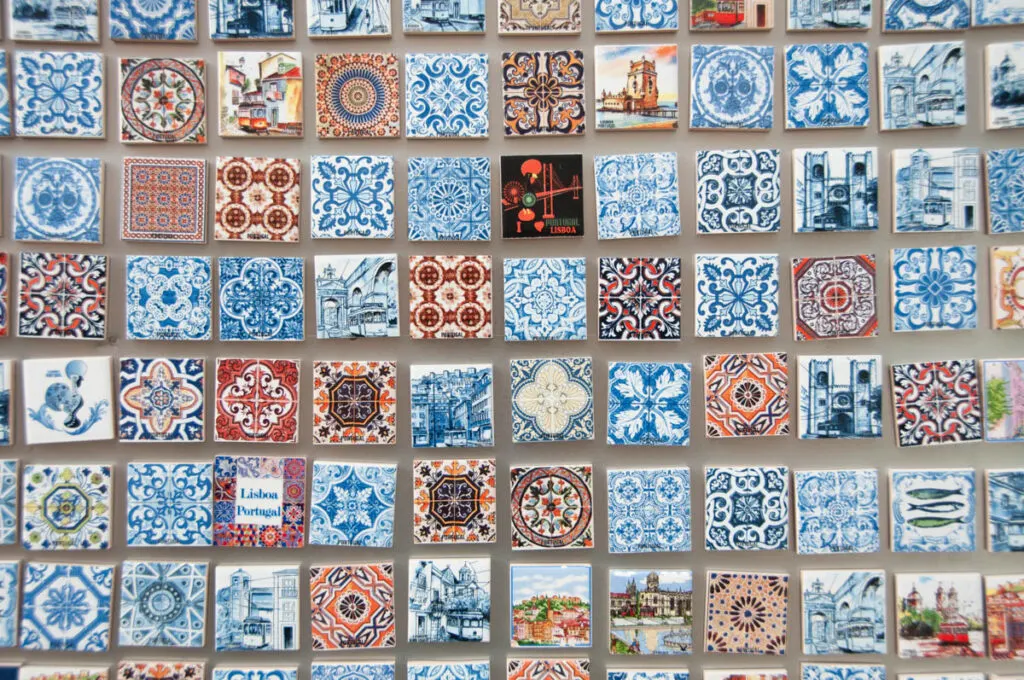
Prometeu Artesanato have three shops in downtown Porto. These boutique shops sell beautiful artisanal tiles, ceramics and other Portugese wares. From multi-tile panels to single tiles, coasters and pot stands or small hand-painted magnets the choice is literally endless.
You’ll also find the ubiquitous souvenir fridge magnet in lots of different designs and colourways decorating the market stalls along the Ribeira and they can be found in every souvenir and gift shop.
Pick up a handful of these azulejo magnets and you could actually reproduce your own azulejo tile work of art on your fridge when you get back home!
The creative amongst you might want to book into an azulejo tile-making workshop and make your very own tiles.
So, that’s where to find the best Azulejos in Porto. I hope it helps on your next visit to the city. Let me know if I’ve missed any of your favourties.
Pin it!



Have you seen Azulejo tiles in Portugal?
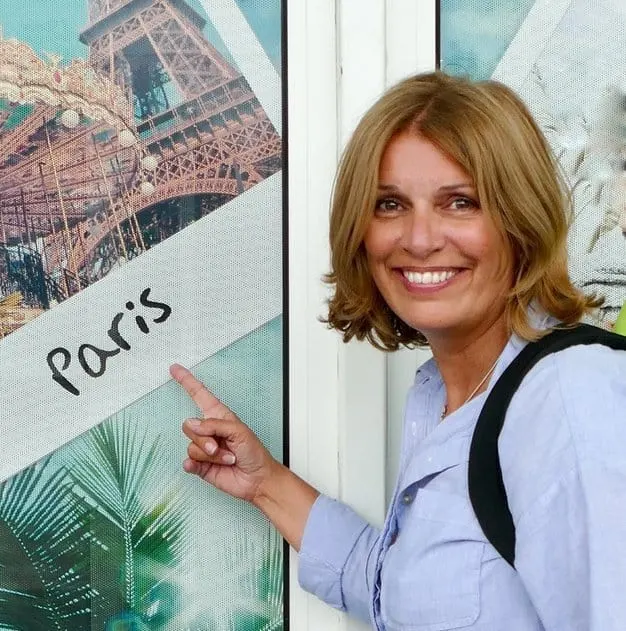
Suzanne Jones is a full-time travel blogger and writer at The Travelbunny which she started in 2011 during her time as a professional travel planner. Suzanne enjoys exploring new destinations, culinary encounters and the outdoors. When not travelling or writing about her adventures you’ll most likely find her, camera in hand, enjoying coastal walks in Sussex.
Suzanne also runs Hello Sussex a website which showcases the best of East & West Sussex. Read more about Suzanne.





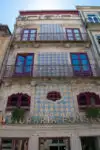
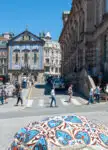
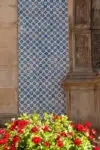

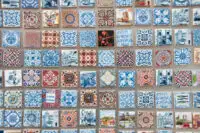

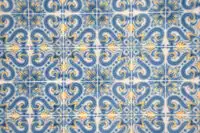
Rachel
Wednesday 26th of August 2015
Wow, there are even more tiles that I could possibly have dreamt of! I'm totally obsessed with tiles and I knew Portugal was the place to go, but never imagined so much! I've only seen a hint of them in Macau. I definitely need to get down there. Great documentation of them Suzanne, saw your pin on Pinterest with much glee!
Suzanne Jones
Wednesday 26th of August 2015
The tiles are gorgeous - both Lisbon and Porto have some wonderful tiles :) Love Pinterest - I could/do spend hours dreaming over the travel boards!
Packing my Suitcase
Thursday 23rd of July 2015
As Brazil was colonized by the Portuguese, we also have lots of azulejos there, mainly in old buildings. Nowadays we still use them, mainly in the bathrooms or for decorating a certain room in the house. I love it! There isn't something like this here in Germany. Love your photos, especially the one with the Vespa <3
Suzanne Jones
Friday 24th of July 2015
The tiles were really lovely and add such a lot of colour to the buildings - there were some beautiful azuljos in Lisbon too. I love the word 'azulejos' too - just rolls off the tongue!
Atrio
Monday 13th of July 2015
If you love Portuguese Azulejo Tiles, you will also love my jewelry. How about wearing a Piece of History? Portuguese Antique Tile Replica jewelry by Atrio https://www.etsy.com/shop/Atrio?ref=hdr_shop_menu
What to See and Do in Porto | The Travelbunny
Sunday 12th of July 2015
[…] painted by Jorge Colaço, the most important azulejo painter of the time from 1905-1916. There are azulejo tiles all over the city but none with such fascinating scenarios and historical stories. Be careful – […]
Sand In My Suitcase
Monday 6th of July 2015
That railway station looks like a visitor attraction in and of itself! We visited Portugal shortly after getting married, but after spending time in Cascais and Estoril, we headed south from Lisbon. Next time, we'd love to head north to Porto. We bought some tiles though, which we lugged home, thinking one day we could use them as decorative tiles in a bathroom renovation (they're still sitting in the garage, however). So much for the bathroom reno!
Suzanne Jones
Monday 6th of July 2015
I'd like to explor Cascais, Sintra and Estoril - Ihave a cupboard full of souvenirs that never see the light of day!